2013 Peugeot 508 RXH 4 wheel drive
[x] Cancel search: 4 wheel drivePage 132 of 308
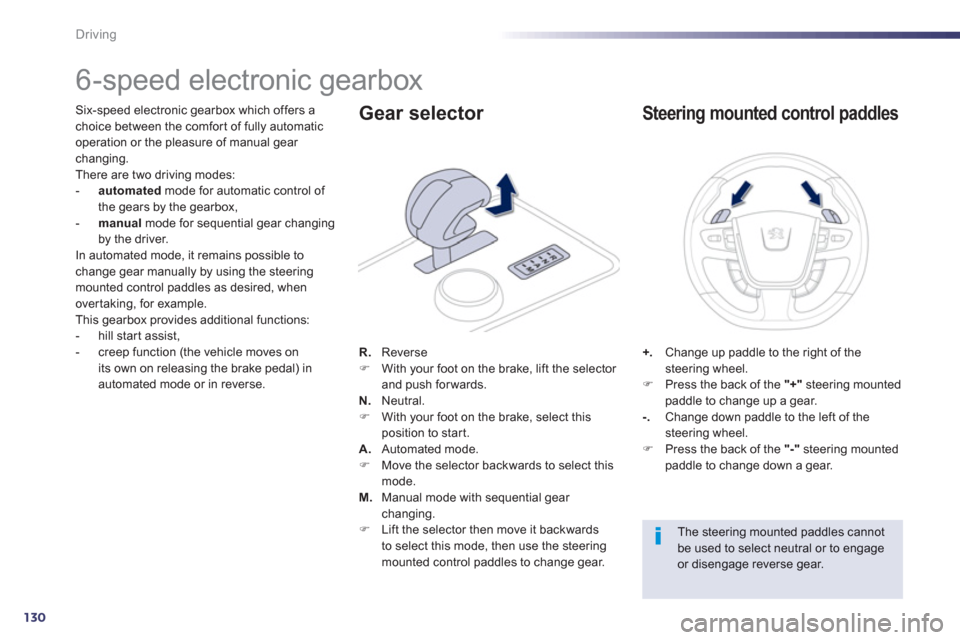
130
Driving
6-speed electronic gearbox
Six-speed electronic gearbox which offers achoice between the comfor t of fully automatic
operation or the pleasure of manual gear changing.There are two driving modes: -automatedmode for automatic control of
the gears by the gearbox,- manualmode for sequential gear changing
by the driver.
In automated mode, it remains possible to
change gear manually by using the steering mounted control paddles as desired, when
over taking, for example.
This gearbox provides additional functions:
- hill star t assist,
- creep function (the vehicle moves on its own on releasing the brake pedal) in automated mode or in reverse.R
. Reverse �)
With your foot on the brake, lift the selector
and push forwards.
N
. Neutral. �) With your foot on the brake, select this
position to start.A. Automated mode.�)
Move the selector backwards to select this
mode. M. Manual mode with sequential gear changing. �)
Lift the selector then move it backwards
to select this mode, then use the steeringmounted control paddles to change gear.
Gear selector
+. Change up paddle to the right of the steering wheel.�)Press the back of the "+"
steering mounted paddle to change up a gear.-.
Change down paddle to the left of thesteering wheel.�)Press the back of the "-"steering mounted paddle to change down a gear.
Steering mounted control paddles
The steering mounted paddles cannot
be used to select neutral or to engageor disengage reverse gear.
Page 176 of 308
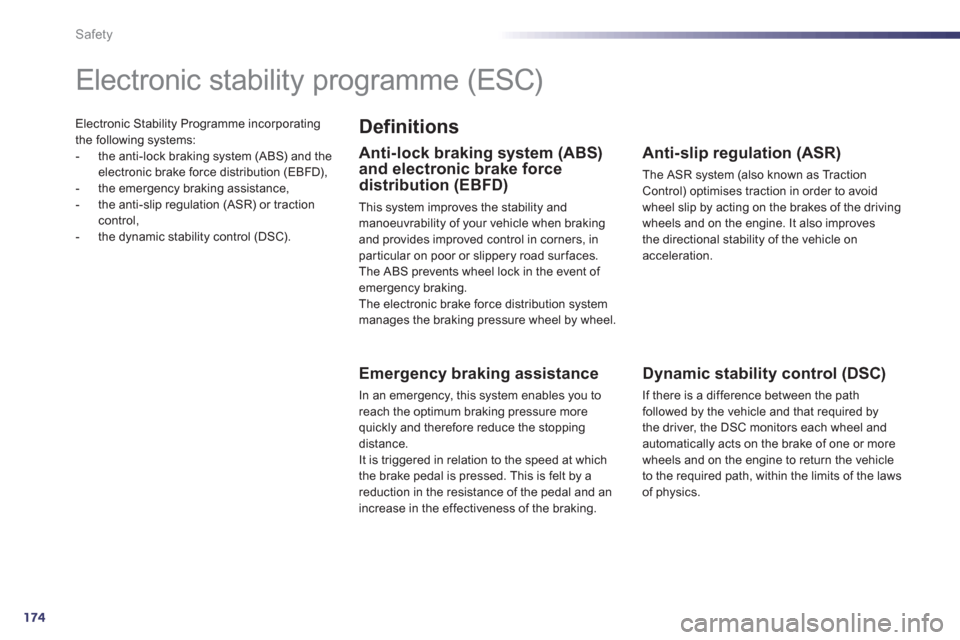
174
Safety
Electronic Stability Programme incorporatingthe following systems:
- the anti-lock braking system (ABS) and the
electronic brake force distribution (EBFD),
- the emergency braking assistance,
- the anti-slip regulation (ASR) or traction control,
- the d
ynamic stability control (DSC).
Electronic stability programme (ESC)
Definitions
Anti-lock braking system (ABS)
and electronic brake force
distribution
(EBFD)
This system improves the stability and
manoeuvrability of your vehicle when braking
and provides improved control in corners, in
par ticular on poor or slippery road surfaces.
The ABS prevents wheel lock in the event of emergency braking.
The electronic brake force distribution system
manages the braking pressure wheel by wheel.
Emergency braking assistance
In an emergency, this system enables you to reach the optimum braking pressure more quickly and therefore reduce the stoppingdistance.
It is triggered in relation to the speed at which
the brake pedal is pressed. This is felt by areduction in the resistance of the pedal and an
increase in the effectiveness of the braking.
Anti-slip regulation (ASR)
The ASR system (also known as Traction Control) optimises traction in order to avoid
wheel slip by acting on the brakes of the drivingwheels and on the engine. It also improves
the directional stability of the vehicle onacceleration.
Dynamic stability control (DSC)
If there is a difference between the pathfollowed by the vehicle and that required bythe driver, the DSC monitors each wheel and
automatically acts on the brake of one or more
wheels and on the engine to return the vehicle
to the required path, within the limits of the laws
o
f physics.
Page 178 of 308
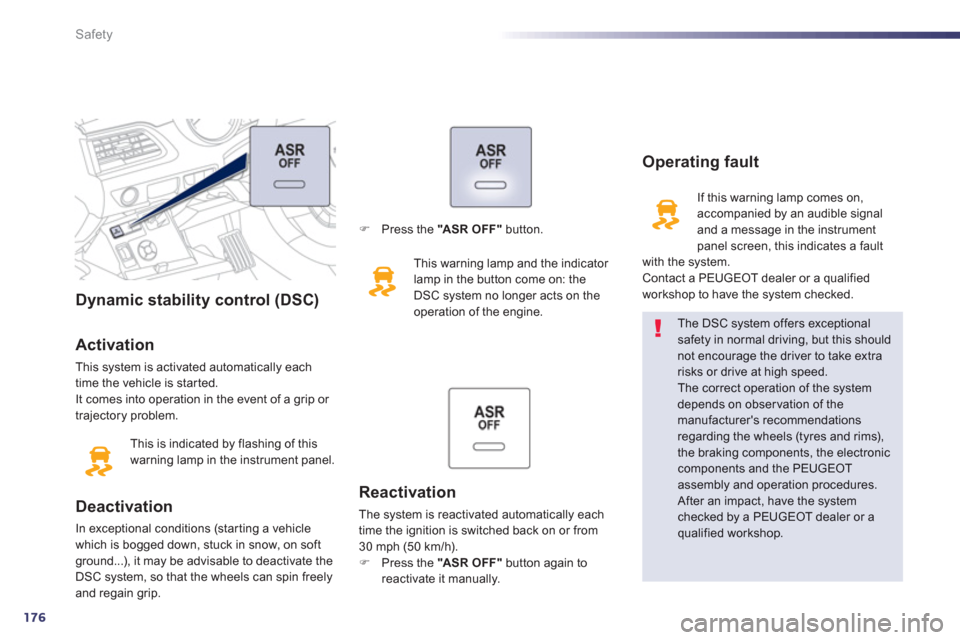
176
Safety
Dynamic stability control (DSC)
Activation
This system is activated automatically each
time the vehicle is started.
It comes into operation in the event of a grip or
trajectory problem.
This is indicated b
y flashing of this
warning lamp in the instrument panel.
Deactivation
In exceptional conditions (starting a vehicle
which is bogged down, stuck in snow, on softground...), it may be advisable to deactivate the
DSC system, so that the wheels can spin freely and regain grip.
The DSC system offers exceptional safety in normal driving, but this should not encourage the driver to take extra risks or drive at high speed.
The correct operation of the system depends on obser vation of the manufacturer's recommendationsregarding the wheels (tyres and rims),the braking components, the electronic components and the PEUGEOTassembly and operation procedures.
After an impact, have the systemchecked by a PEUGEOT dealer or aqualified workshop.
Operating fault
If this warning lamp comes on,
accompanied by an audible signal
and a messa
ge in the instrument
panel screen, this indicates a fault
with the s
ystem.
Contact a PEUGEOT dealer or a qualified
workshop to have the system checked.
Reactivation
The system is reactivated automatically eachtime the ignition is switched back on or from
30 mph (50 km/h).�) Press the "ASROFF"button again to
reactivate it manually.
�) Press the "ASR OFF"button.
This warnin
g lamp and the indicator
lamp in the button come on: the
D
SC system no longer acts on the
operation of the engine.
Page 182 of 308
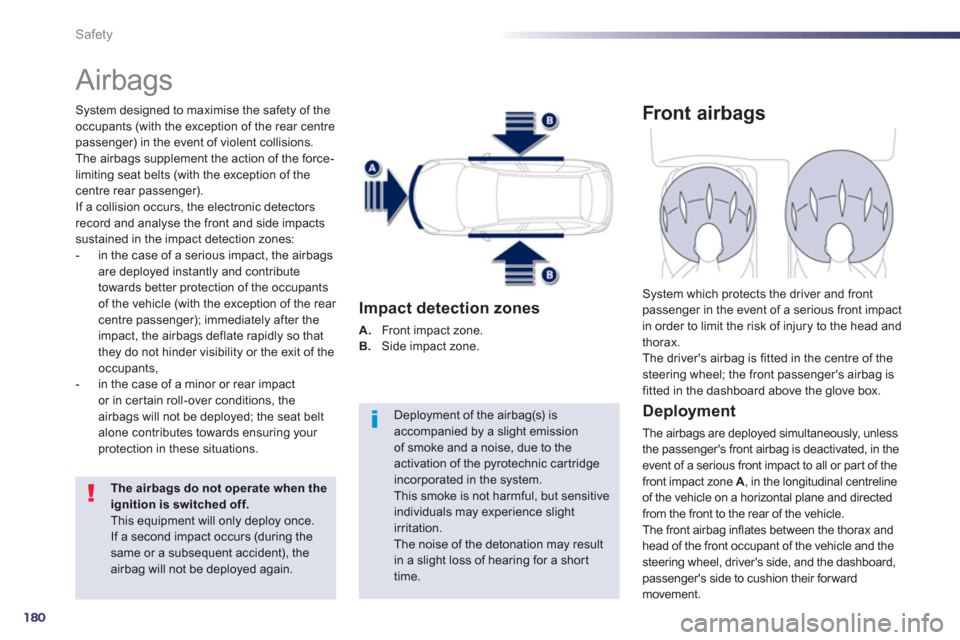
180
Safety
Airbags
System designed to maximise the safety of the
occupants (with the exception of the rear centrepassenger) in the event of violent collisions.
The airbags supplement the action of the force-
limiting seat belts (with the exception of the centre rear passenger).
If a collision occurs, the electronic detectors record and analyse the front and side impacts sustained in the impact detection zones:
- in the case of a serious impact, the airbagsare deployed instantly and contribute
towards better protection of the occupants
of the vehicle
(with the exception of the rear centre passenger); immediately after theimpact, the airbags deflate rapidly so that
they do not hinder visibility or the exit of the
occupants,
- in the case of a minor or rear impact
or in cer tain roll-over conditions, the
airbags will not be deployed; the seat belt
alone contributes towards ensuring your protection in these situations.
The airbags do not operate when the ignition is switched off.
This equipment will only deploy once.
If a second impact occurs (during thesame or a subsequent accident), theairbag will not be deployed again.
Deployment of the airbag(s) is accompanied by a slight emission of smoke and a noise, due to theactivation of the pyrotechnic cartridgeincorporated in the system.This smoke is not harmful, but sensitiveindividuals may experience slight irritation.
The noise of the detonation may result in a slight loss of hearing for a shorttime.
Impact detection zones
A.
Front impact zone. B.
Side impact zone.
Front airbags
Deployment
The airbags are deployed simultaneously, unless
the passenger's front airbag is deactivated, in the event of a serious front impact to all or part of thefront impact zone A, in the longitudinal centreline
of the vehicle on a horizontal plane and directedfrom the front to the rear of the vehicle.
The front airbag inflates between the thorax andhead of the front occupant of the vehicle and thesteering wheel, driver's side, and the dashboard,passenger's side to cushion their for ward movement.
System which protects the driver and frontpassenger in the event of a serious front impact
in order to limit the risk of injury to the head and
thorax.
The driver's airbag is fitted in the centre of the steering wheel; the front passenger's airbag isfitted in the dashboard above the glove box.
Page 185 of 308
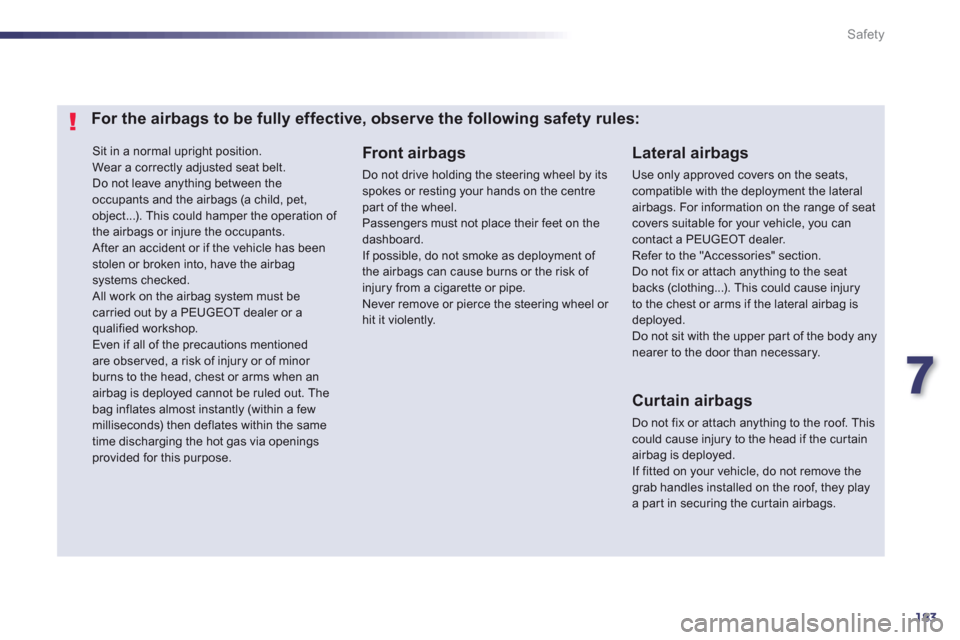
7
183
Safety
Sit in a normal upright position. Wear a correctly adjusted seat belt.
Do not leave anything between theoccupants and the airbags (a child, pet, object...). This could hamper the operation of the airbags or injure the occupants. After an accident or if the vehicle has beenstolen or broken into, have the airbagsystems checked. All work on the airbag system must be carried out by a PEUGEOT dealer or a qualified workshop.
Even if all of the precautions mentionedare obser ved, a risk of injury or of minor burns to the head, chest or arms when an airbag is deployed cannot be ruled out. Thebag inflates almost instantly (within a fewmilliseconds) then deflates within the same
time discharging the hot gas via openings provided for this purpose.
Lateral airbags
Use only approved covers on the seats, compatible with the deployment the lateralairbags. For information on the range of seatcovers suitable for your vehicle, you can contact a PEUGEOT dealer. Refer to the "Accessories" section.Do not fix or attach anything to the seatbacks (clothing...). This could cause injuryto the chest or arms if the lateral airbag isdeployed.Do not sit with the upper par t of the body anynearer to the door than necessary.
Front airbags
Do not drive holding the steering wheel by itsspokes or resting your hands on the centre part of the wheel.
Passengers must not place their feet on thedashboard.
If possible, do not smoke as deployment of the airbags can cause burns or the risk of injury from a cigarette or pipe.
Never remove or pierce the steering wheel or hit it violently.
Curtain airbags
Do not fix or attach anything to the roof. This
could cause injury to the head if the cur tain airbag is deployed.If fitted on your vehicle, do not remove thegrab handles installed on the roof, they play a part in securing the cur tain airbags.
For the airbags to be fully effective, observe the following safety rules:
Page 186 of 308
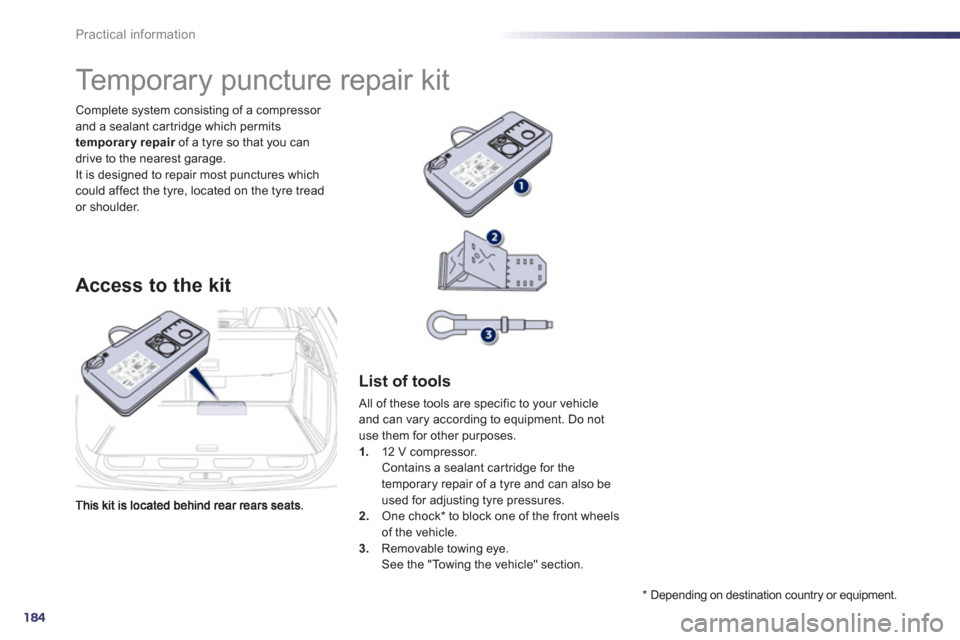
184
Practical information
Complete system consisting of a compressor and a sealant car tridge which permits
temporary repair of a tyre so that you can rdrive to the nearest garage.It is designed to repair most punctures which could affect the tyre, located on the tyre tread or shoulder.
Temporary puncture repair kit
Access to the kit
List of tools
All of these tools are specific to your vehicle
and can vary according to equipment. Do not
use them for other purposes. 1.12 V compressor.
Contains a sealant car tridge for the
temporary repair of a tyre and can also be used for adjusting tyre pressures.
2. One chock *
to block one of the front wheels of the vehicle.3.
Removable towing eye.
See the "Towing the vehicle" section.
*
Dependin
g on destination country or equipment.
Page 190 of 308
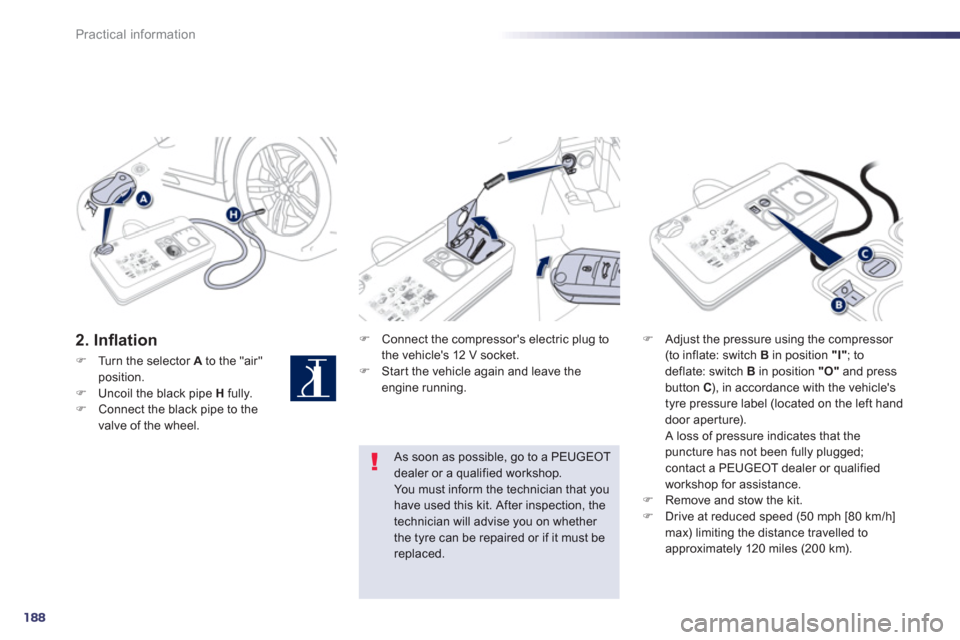
188
Practical information
2. Infl ation �)
Connect the compressor's electric plug to
the vehicle's 12 V socket.�) Star t the vehicle again and leave the engine running.
�)Adjust the pressure using the compressor (to inflate: switch B
in position "I"
; to deflate: switch B
in position "O"and press button C), in accordance with the vehicle's
tyre pressure label (located on the left hand
door aperture).
A loss of pressure indicates that thepuncture has not been fully plugged; contact a PEUGEOT dealer or qualified
workshop for assistance.�)Remove and stow the kit.�)Drive at reduced speed (50 mph [80 km/h] max) limiting the distance travelled to
approximately 120 miles (200 km).
As soon as possible, go to a PEUGEOTdealer or a qualified workshop.You must inform the technician that you have used this kit. After inspection, the technician will advise you on whether
the tyre can be repaired or if it must be replaced.
�)Turn the selector Ato the "air" position.�)Uncoil the black pipe Hfully. �)Connect the black pipe to the
valve of the wheel.
Page 197 of 308
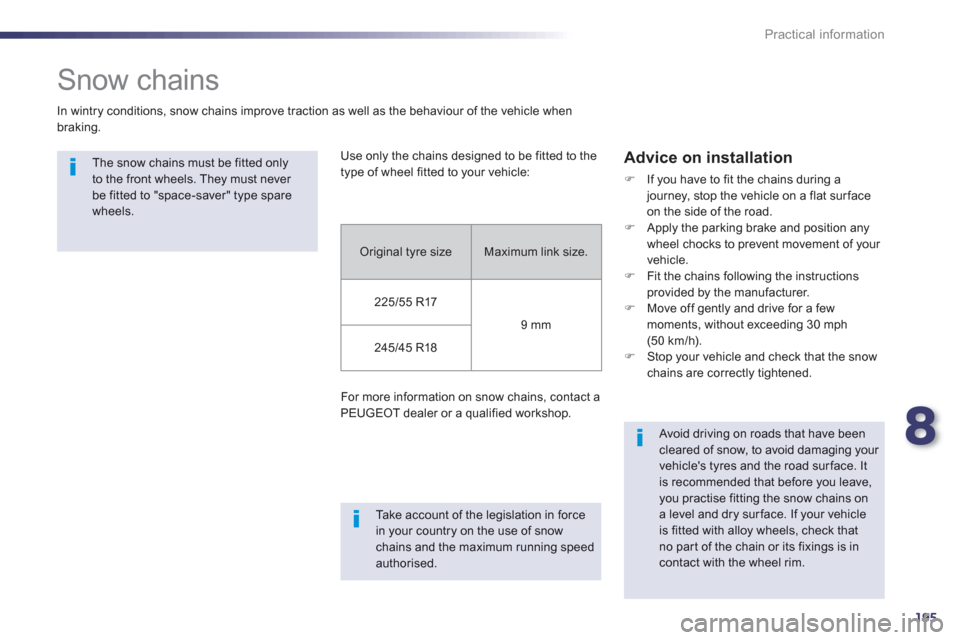
8
195
Practical information
Snow chains
In wintry conditions, snow chains improve traction as well as the behaviour of the vehicle when
braking.
Take account of the legislation in force in your country on the use of snowchains and the maximum running speedauthorised.
The snow chains must be fitted only to the front wheels. They must never be fitted to "space-saver" type sparewheels.
For more in
formation on snow chains, contact a PEUGEOT dealer or a qualified workshop.
Advice on installation
�)
If you have to fit the chains during ajourney, stop the vehicle on a flat sur face on the side of the road.�)
Apply the parking brake and position anywheel chocks to prevent movement of your
vehicle. �) Fit the chains following the instructions provided by the manufacturer.�)
Move off gently and drive for a few moments, without exceeding 30 mph(50 km/h). �)
Stop your vehicle and check that the snowchains are correctly tightened.
Avoid driving on roads that have beencleared of snow, to avoid damaging your vehicle's tyres and the road surface. It is recommended that before you leave,you practise fitting the snow chains ona level and dry surface. If your vehicleis fitted with alloy wheels, check thatno par t of the chain or its fixings is incontact with the wheel rim.
Use onl
y the chains designed to be fitted to the
type of wheel fitted to your vehicle:
Original tyre size Maximum link size.
225/55 R17
9 mm
24
5/45 R18